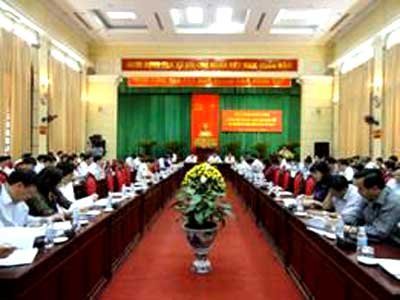 |
| Delegates at the meeting. (Photo: cpv.org.vn) |
Statistics released at the meeting show that the percentage of projects which have received permission for construction increased from 67% in 2006 to nearly 90% in 2008.
In the first six months of 2012, the municipal authorities have issued nearly 4,500 building permits with a total floor area of over 1.5 million square metres.
The city has resolved 203 of almost 600 cases of super-thin and super-distorted buildings, while work on the remaining cases is in progress and should be completed soon.
However, construction violations still remain common. Currently, the city has recorded 1,700 projects that have violated rules, including more than 1,100 construction sites located on agricultural and public land, 490 cases of unauthorised construction, and the remaining 100 cases of projects which did not follow the terms of their licences.
The districts of Quoc Oai, Soc Son and Thanh Tri have seen the highest rate of violations. Some prominent cases include a housing project at Mo Lao urban area in Ha Dong district, a construction site at Tran Quoc Hoan street in Cau Giay district, a project at No. 55A, 55B, 53D on Ba Trieu street in Hoan Kiem district, and a land encroachment and unauthorised construction project of the Vietnam Buddhist Institute in Phu Linh commune, Soc Son district.
Addressing the meeting, Politburo member and secretary of the Hanoi Party Committee Pham Quang Nghi pointed out that the main reasons for the high rate of violators are investors’ poor awareness, weak inspection work, and loose management of public and agricultural land, as well as inadequate planning.
Secretary Nghi urged the city sectors, branches and localities to focus on promoting information to raise public awareness of following construction regulations, and to disclose administrative procedures and the city’s urban planning to citizens.
He also suggested strengthening the leadership of administration agencies over construction management, increasing monitoring activities, promoting administrative reform, and increasing responsibilities and co-ordination among branches, sectors and authorities to effectively detect and handle any violations, as well as proposing stricter punishment against serious offenses.
VietNamNet/Nhan Dan